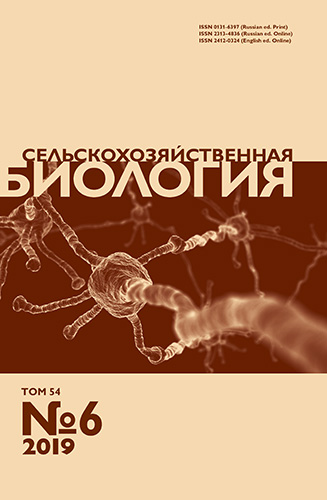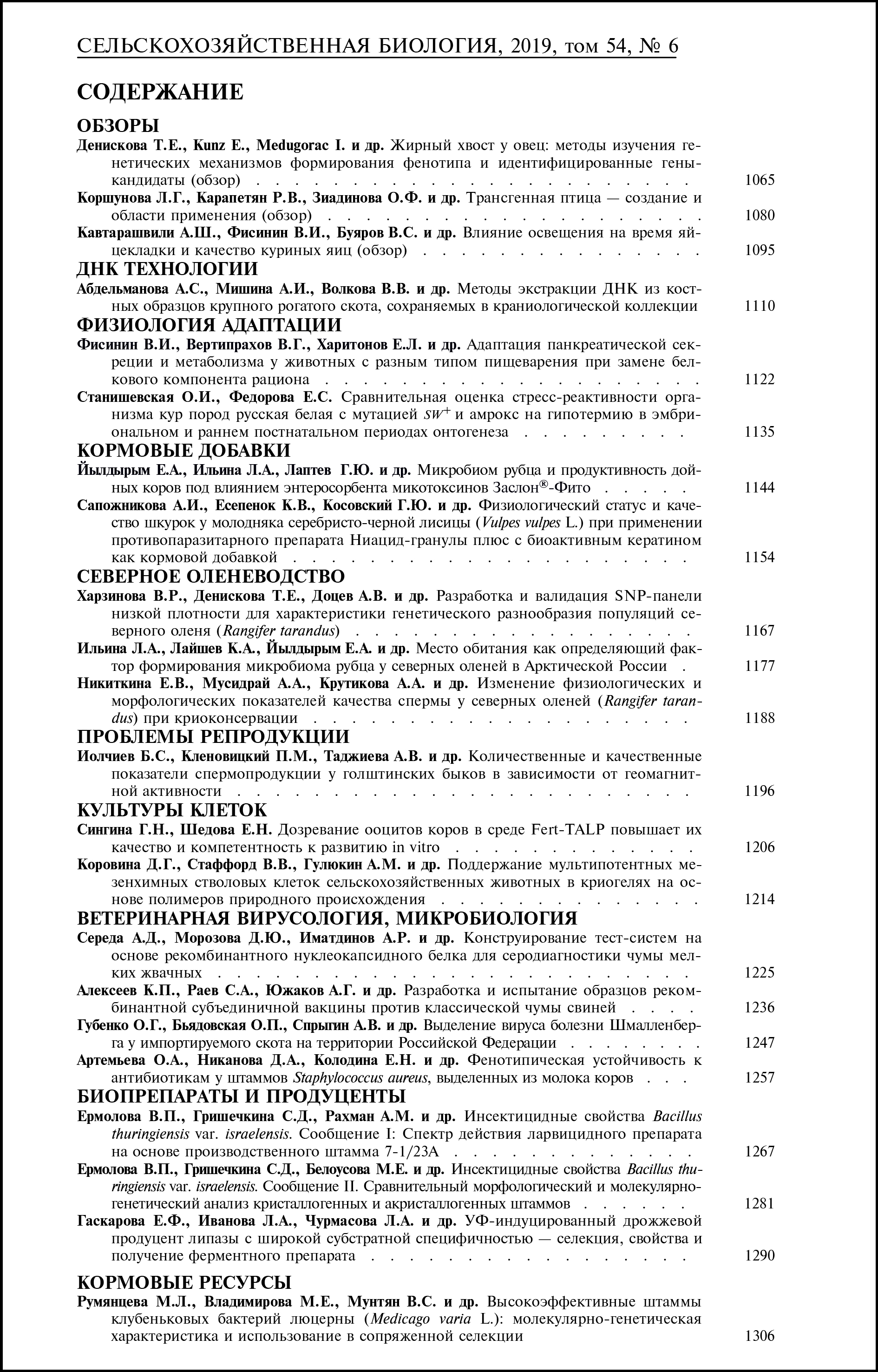doi: 10.15389/agrobiology.2019.6.1080rus
УДК 636.5:57.08:577.21
ТРАНСГЕННАЯ ПТИЦА — СОЗДАНИЕ И ОБЛАСТИ ПРИМЕНЕНИЯ
(обзор)
Л.Г. КОРШУНОВА, Р.В. КАРАПЕТЯН, О.Ф. ЗИАДИНОВА,
В.И. ФИСИНИН
Технологии трансгенеза в птицеводстве могут быть направлены на улучшение качественных и количественных характеристик продукции (Л.Г. Коршунова, 2011), создание птицы, генетически устойчивой к инфекционным заболеваниям и продуцирующей с яйцом рекомбинантные белки различного назначения (D. Cao с соавт., 2015). Для получения трансгенных животных чаще всего прибегают к микроинъекции ДНК в зиготы. Однако особенности размножения птиц создают серьезные проблемы для исследователей. Курица образует в сутки одну оплодотворенную яйцеклетку, которая очень велика и нежна для каких-либо манипуляций с ней. Для нормального эмбрионального развития ей необходимы третичные оболочки — белковая, подскорлупные и скорлупа. Дробление куриной яйцеклетки начинается уже в белковом отделе яйцевода, а в свежеснесенном яйце имеется 50-60 тыс. клеток. Первая трансгенная птица была получена с помощью ретровирусных векторов. В нормальных условиях ретровирусы сами включаются в геномную ДНК хозяина и реплицируются. На сегодняшний день трансгенные куры и перепела получены посредством ретровирусного (D.W. Salter с соавт., 1989; R.A. Bosselman с соавт., 1989; L.B. Crittenden с соавт., 1992) и лентивирусного трансгенеза (H.A. Kaleri с соавт., 2011; A.H. Seidl с соавт., 2013; Н.А. Волкова с соавт., 2015). Эффективные технологии модификации генома кур и перепелов продолжают разрабатываться. К ним относят метод ZFNs (zinc finger nucleases), TALENs (transcription activator-like effector nucleases) (T.S. Park с соавт., 2014), CRISPR/Cas9 (I. Oishi с соавт., 2016; Q. Zuo с соавт., 2016). Технология CRISPR/Cas9 позволяет достичь дальнейшего прогресса в генетических манипуляциях с птицей и создания линий с отредактированным геномом (N. Veron с соавт., 2015). Птичьи эмбрионы, главным образом эмбрионы курицы (Gallus gallus domesticus) и перепела (Coturnix japonica), более века служили моделью в эмбриологических исследованиях позвоночных. Современные целенаправленные генные манипуляции на эмбрионе цыпленка как модели in vivo стали возможны благодаря системе редактирования CRISPR/Cas9 (V. Morin с соавт., 2017). К другим методам создания трансгенных птиц относится получение химер при подсадке в эмбрионы чужих эмбриональных клеток в качестве переносчиков чужеродной ДНК (J.N. Petitte с соавт., 1990; J.Y. Han с соавт., 2017; Н.А. Волкова с соавт., 2017). Трансгенез с использованием сперматозоидов для доставки в зиготу инородного генетического материала представляется весьма заманчивым, поскольку искусственное осеменение широко используется в птицеводстве (E. Harel-Markowitz с соавт., 2009; А.В. Самойлов с соавт., 2013). Использование спермиев для переноса чужеродной ДНК в яйцеклетки птиц в сочетании с технологией CRISPR/Cas9 позволит значительно сократить время и ресурсы, затрачиваемые на создание трансгенных особей с целевым изменением генотипа в первом поколении, что открывает новые возможности для селекции (C.A. Cooper с соавт., 2017). Классической технологией безвирусного трансгенеза остается микроинъекция ДНК в зиготу. Метод включает прямую инъекцию генной конструкции в цитоплазму свежеоплодотворенной яйцеклетки курицы с последующей инкубацией до вылупления. Яйцеклетка для инъекции должна быть получена сразу после оплодотворения, следовательно, ее движение вниз по яйцеводу прерывается. Далее используется специально разработанная система культивирования (C. Mather, 1994). Другой вариант микроинъекций ДНК в яйцеклетку птиц предусматривает образование ее третичных оболочек естественным образом в половых путях птицы. В основе метода лежит хирургическая операция, которая обеспечивает доступ к яйцеклетке, инъекцию в нее ДНК и имплантацию обратно в яйцевод для формирования полноценного инкубационного яйца (Р.В. Карапетян, 1995). Так были созданы трансгенные куры и перепела с различными генными конструкциями (Р.В. Карапетян, 1996; Л.Г. Коршунова с соавт., 2013).
Ключевые слова: трансгенез, птица, ретровирусы, микроинъекции, примордиальные клетки, сперматозоиды, редактирование генома.
TRANSGENIC POULTRY: DERIVATION AND AREAS OF APPLICATION (review)
L.G. Korshunova, R.V. Karapetyan, O.F. Ziadinova, V.I. Fisinin
Transgenic poultry is a powerful instrument for the biotechnologic research in agriculture and medicine as well as a useful biological model (H. Sang, 2004). The technologies of transgenesis can be also aimed at the improvement of qualitative and quantitative characteristics of poultry products (L.G. Korshunova, 2011); development of poultry crosses genetically resistible to infectious diseases (L.G. Korshunova et al., 2014); derivation of poultry that can produce recombinant proteins of different usage areas within the eggs (D. Cao et al., 2015). The most popular way to induce transgenicity is the microinjection of foreign DNA into the ovicell in the proper moment when the organism consists of a single cell (zygote). Certain peculiarities of avian reproduction, however, constrain the induction of the transgenesis. A hen produces daily a single fertilized ovicell which is large in size and extremely sensitive to any manipulation like those to be performed on the mammal ovicells at the injection of foreign DNA. Furthermore, normal embryonic development in avian eggs requires the integrity of tertiary coats — albumen, inner shell membrane, and eggshell itself. The cleavage of chicken ovicell starts as early as in the magnum while freshly laid egg contains ca. 50,000-60,000 cells. As a consequence, first transgenic bird was produced via retroviral vectors. Retroviruses were the first contenders for the role of vectors in the gene transfer since they normally can enter the genomic DNA of the host with subsequent replication. At present the induction of retroviral (D.W. Salter et al., 1986; D.W. et al. Salter, 1987; D.W. et al. Salter, 1989; R.A. Bosselman et al., 1989; L.B. Crittenden, 1991; L.B. Crittenden et al., 1992) and lentiviral (H.A. Kaleri et al., 2011; A.H. Seidl et al., 2013; N.A. Volkova et al., 2015) transgenesis in chicken and quails was reported. The technologies of genomic modification in chicken and quails are continuing their development: e.g. the methods with the use of zinc finger nucleases (ZFNs), transcription activator-like effector nucleases (TALENs) (T.S. Park et al., 2014), CRISPR/Cas9 (I. Oishi et al., 2016; Q. Zuo et al., 2016) were developed. The CRISPR/Cas9 technology allows for the further progress in the genetic manipulations to produce genome-edited lines of poultry (N. Veron et al., 2015). Avian embryos, primarily chicken (Gallus gallus domesticus) and quail (Coturnix coturnix japonica), served as a model for the embryologic studies in vertebrates for more than a century. Modern targeted genetic manipulations in chicken embryo as an in vivo model became possible via the CRISPR/Cas9 editing system (V. Morin et al., 2017). The alternative non-viral methods of the induction of transgenesis in avian species can be used; one of these methods involves the transfer of foreign embryonic cells (as foreign DNA vector) into the recipient embryo resulting in the chimeric birds (J.N. Petitte et al., 1990; J.Y. Han et al., 2017; N.A. Volkova et al., 2017). Another attractive technology for the transfer of foreign genetic material into avian embryos involves the use of spermatozoa as the vectors since artificial insemination is the traditional and common technique for poultry (E. Harel-Markowitz et al., 2009; A.V. Samoylov et al., 2013). The combination of spermatozoa vectors and CRISPR/Cas9 technology can result in transgenesis in the first generation and hence allows for the substantial savings in time and resources (C.A. Cooper et al., 2017). The microinjection of DNA into the zygote is still a classic technology of non-viral transgenesis. The method involves direct injection of gene construct into the cytoplasm of freshly fertilized ovicell and subsequent incubation of injected eggs. The ovicell for injection should be taken immediately after its fertilization which means that its movement down the oviduct should be interrupted; further development of the injected embryo require special cultivation system (C. Mather, 1994). Another microinjection technique for avian ovicells involves natural formation of tertiary coats in the oviduct. The method is based on the surgical operation to get the access to the ovicell, its microinjection with foreign DNA, and implantation of injected ovicell back to the maternal oviduct for the formation of normal egg suitable for incubation (R.V. Karapetyan, 1995). The populations of transgenic chicken and quails with different foreign gene constructs were produced with the use of this method (R.V. Karapetyan, 1996; L.G. Korshunova et al., 2013).
Keywords: transgenesis, poultry, retroviruses, microinjection, primordial cells, sperm cells, genome editing.
ФНЦ Всероссийский научно-исследовательский |
Поступила в редакцию |












